Hello, every one, I would like to introduce our new product "VT DSO-2810F" here. Together with the Multi-Instrument software, it turns your PC into a 2x100MHz Oscilloscope, Spectrum Analyzer, Multimeter, Signal Generator. (Note: The Signal Generator function is available via sound card or other DAC device, rather than the VT DSO-2810F unit). The unit is small, portable and has a metal enclosure. The price is US$250 (FREE shipping worldwide).
The Multi-Instrument software can be downloaded and tried for 21 days with full functionality using your computer's sound card for ADC and DAC at:
www.virtins.com/MIsetup.exe
or
www.multi-instrument.com/MIsetup.exe
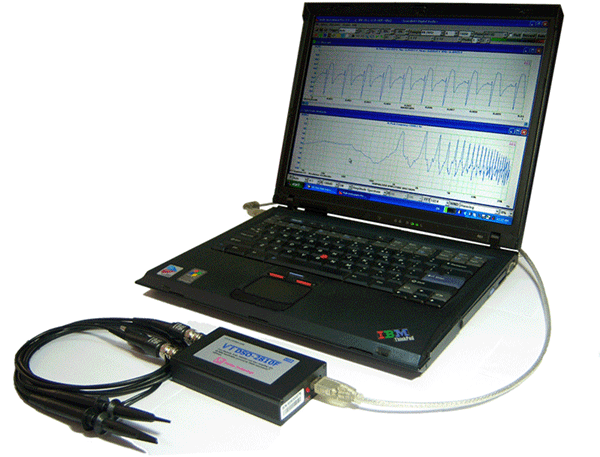
Turn a PC into multiple virtual instruments!
1. Package Contents
1) VT DSO-2810F unit with a hardware bundled Multi-Instrument Standard software license
2) 2x100MHz Oscilloscope Probe P2100 with two switchable positions: x1, x10
3) USB cable (1.5 m)
4) CD (contains the copy-protected Multi-Instrument software and VT DSO-2810F driver)
2. VT DSO-2810F Hardware Specifications
1) Sampling Frequency: 100MHz, 50MHz, 20MHz, 10MHz, 5MHz, 2MHz, 1MHz, 500kHz, 200kHz, 100kHz, 50kHz, 20kHz
2) Analog Bandwidth: 40MHz
3) Number of Input Channels: 2
4) ADC Bit Resolution: 8 Bit
5) Input Voltage Range: (+-)1.2V*, (+-)12V*, (+-)24V* (one selector for two channels)
6) Maximum Allowed Input Voltage:
(+-)1.2V*: <= (+-)10V
(+-)12V*: <= (+-)24V
(+-)24V*: <=(+-)24V
7) Coupling Type: AC/DC (one selector for two channels)
8) Input Isolation: No
9) Terminal Type: Referenced Single-Ended
10) Buffer Size: 2000 bytes per Channel
11) Scan Time: 20us~100ms (with buffer fully filled)
12) Trigger Source: CH1 only
13) Trigger Level: Around 0V
14) Trigger Edge: Rising, Falling
15) Trigger Mode: Auto (Free Run), Normal
16) Input Impedance: 1 Mohms , 13 pF
17) Rising Time: <10ns
18) Streaming Supported: No
19) Interface: USB
20) Casing: Metal
21) Device Category in Multi-Instrument: VT DSO F1
22) Power: Bus powered by USB port, no external power source required.
23) Power Consumption: Max. 1.5W
24) Dimensions: 132 mm (L) x 63 mm (W) x 24 mm (H)
25) System Requirement: Windows 98 or above
*Under these input voltage range selections, the actual measurement range is: -1.05V~1.12V, -10.5V~11.2V, -21V~22.4V respectively.
3. Introduction of Multi-Instrument 3.1 (Standard)
Multi-Instrument 3.1 (Standard) is a powerful PC based multi-function virtual instrument software. It supports a variety of hardware ranging from sound cards which are available in almost all computers to proprietary ADC and DAC hardware such as VT DSO-2810F, NI DAQmx cards and so on. It consists of a dual trace oscilloscope, a real time spectrum analyzer, a signal generator and a multimeter, and can run them simultaneously.
For a sound card based system, software triggering is supported. It features a specially designed data acquisition approach, which is able to monitor the input signal continuously without missing any trigger event before a frame of data is collected. It has a very fast screen refresh rate (typically greater than 50 frames per second). It supports sophisticated triggering method including pre-trigger and post-trigger. Both level trigger and differential trigger are supported. For a non sound card based system, the triggering capability depends on the hardware used. Hardware triggering is supported if the hardware used supports it. Software triggering is supported if the hardware used supports data streaming.
The software has a multilingual user interface, including English, French, German, Italian, Spanish, Portuguese, Russian, Simplified Chinese, Traditional Chinese, Japanese, and Korean. It has been widely used in education, scientific research, audio engineering, electronic engineering, medical diagnosis, vibration analysis, etc.
4. Functions of Multi-Instrument 3.1 (Standard)
A comprehensive range of functions are provided in Multi-Instrument (Standard), including:
(1) Oscilloscope
Oscilloscope Mode: dual-trace waveform, waveform addition, subtraction and multiplication, Lissajous Pattern, transient signal recording, voltmeter.
Record Mode: Record data to the hard disk continously until the recording process is stopped manually or 2 gigabytes of data has been recorded, whichever is earlier. During the recording process, acquired data will still be analyzed and displayed to keep the screen updated in real time.
Roll Mode: Data displayed in the Oscilloscope will shift left gradually while the newly acquired data are added from the right.
(2) Spectrum Analyzer
RMS amplitude spectrum, relative amplitude spectrum, octave analysis (1/1,1/3,1/6,1/12,1/24, 1/48, 1/96), frequency compensation, frequency weighting (A,B,C,ITU-R 468), moving average smoothing, peak hold, linear average, exponential average, measurement of THD, THD+N, SNR, SINAD, Noise Level, IMD, Bandwidth, Crosstalk, Harmonics, Peaks, and Energy in user defined frequency bands, phase spectrum, auto correlation function, cross correlation function.
(3) Signal Generator
Function generation, multitone generation, arbitrary waveform generation, burst tone generation, MLS generation, DTMF generation, musical scale generation, white noise and pink noise generation, and frequency/amplitude sweep signal generation. Fade In / Fade Out of the output signal.
(4) Multimeter
RMS, dBV, dBu, dBSPL, dB(A), dB(B), dB(C), Frequency Counter, RPM, Counter, Duty Cycle, Frequency/Voltage Converstion, Cycle RMS, Cycle Mean. The latter seven modes involves a pulse counting process, with the counter trigger level, hysteresis, frequency dividing ratio adjustable.
5. Extended use of the Multi-Instrument Software
With the VT DSO-2810F unit connected to the computer, the Multi-Instrument software will run under the licensed mode. In Multi-Instrument, the ADC device and DAC device can be independently selected. For example, you can use the VT DSO-2810F as the ADC device and your computer's sound card as the DAC device, and they can work simultaneously. Or, you can use the sound card for both ADC and DAC. Note: the test lead (or probe) for sound card is not included in this pacakge, but you can make the connection by yourself or purchase it from us separately.
6. Software License Information
Multi-Instrument has six levels: Sound Card Oscilloscope, Sound Card Spectrum Analyzer, Sound Card Signal Generator, Multi-Instrument Lite, Multi-Instrument Standard, Multi-Instrument Pro.
Multi-Instrument has five add-on modules/functions are: Spectrum 3D Plot, Data Logger, LCR Meter), Device Test Plan, Vibrometer.
The standard package of VT DSO-2810F contains one hardware bundled license of Multi-Instrument (Standard) without any add-on modules/functions. "Hardware bundled" means that the VT DSO-2810F hardware unit must be connected to the computer in order for the software to work under the licensed mode. Otherwise the software will work in 21-day fully functional trial mode. No softkey (activation code) and hardkey (dongle) will be given under the hardware bundled license.
7. Software Upgrade policy
Software upgrade in the same level is always FREE. When a new version is available, you can just uninstall your current version, download and re-install the new version, as long as the VT DSO-2810F unit is still supported by the new version.
Software upgrade to a higher level can be purchased from our webiste. The license bundled within the VT DSO-2810F hardware unit is remotely upgradable.
8. Refund Policy
One year warranty against defective materials and manufacutring defects for all hardware parts inside the package.
Return for malfuntional item is accepted for refund within 7 days after you receive the item. For full refund, the package must be in the same condition as received with all accessories. The delivery of the returned item must be prepaid by the customer. You must contact us first before you return it.
9. Screenshote examples
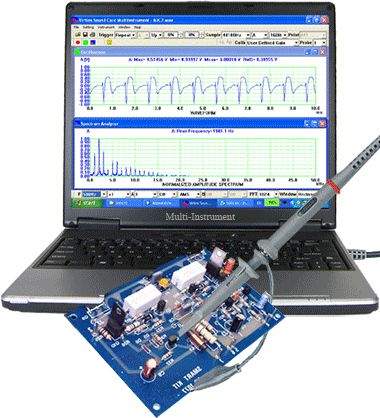
The Multi-Instrument software can be downloaded and tried for 21 days with full functionality using your computer's sound card for ADC and DAC at:
www.virtins.com/MIsetup.exe
or
www.multi-instrument.com/MIsetup.exe

Turn a PC into multiple virtual instruments!
1. Package Contents
1) VT DSO-2810F unit with a hardware bundled Multi-Instrument Standard software license
2) 2x100MHz Oscilloscope Probe P2100 with two switchable positions: x1, x10
3) USB cable (1.5 m)
4) CD (contains the copy-protected Multi-Instrument software and VT DSO-2810F driver)
2. VT DSO-2810F Hardware Specifications
1) Sampling Frequency: 100MHz, 50MHz, 20MHz, 10MHz, 5MHz, 2MHz, 1MHz, 500kHz, 200kHz, 100kHz, 50kHz, 20kHz
2) Analog Bandwidth: 40MHz
3) Number of Input Channels: 2
4) ADC Bit Resolution: 8 Bit
5) Input Voltage Range: (+-)1.2V*, (+-)12V*, (+-)24V* (one selector for two channels)
6) Maximum Allowed Input Voltage:
(+-)1.2V*: <= (+-)10V
(+-)12V*: <= (+-)24V
(+-)24V*: <=(+-)24V
7) Coupling Type: AC/DC (one selector for two channels)
8) Input Isolation: No
9) Terminal Type: Referenced Single-Ended
10) Buffer Size: 2000 bytes per Channel
11) Scan Time: 20us~100ms (with buffer fully filled)
12) Trigger Source: CH1 only
13) Trigger Level: Around 0V
14) Trigger Edge: Rising, Falling
15) Trigger Mode: Auto (Free Run), Normal
16) Input Impedance: 1 Mohms , 13 pF
17) Rising Time: <10ns
18) Streaming Supported: No
19) Interface: USB
20) Casing: Metal
21) Device Category in Multi-Instrument: VT DSO F1
22) Power: Bus powered by USB port, no external power source required.
23) Power Consumption: Max. 1.5W
24) Dimensions: 132 mm (L) x 63 mm (W) x 24 mm (H)
25) System Requirement: Windows 98 or above
*Under these input voltage range selections, the actual measurement range is: -1.05V~1.12V, -10.5V~11.2V, -21V~22.4V respectively.
3. Introduction of Multi-Instrument 3.1 (Standard)
Multi-Instrument 3.1 (Standard) is a powerful PC based multi-function virtual instrument software. It supports a variety of hardware ranging from sound cards which are available in almost all computers to proprietary ADC and DAC hardware such as VT DSO-2810F, NI DAQmx cards and so on. It consists of a dual trace oscilloscope, a real time spectrum analyzer, a signal generator and a multimeter, and can run them simultaneously.
For a sound card based system, software triggering is supported. It features a specially designed data acquisition approach, which is able to monitor the input signal continuously without missing any trigger event before a frame of data is collected. It has a very fast screen refresh rate (typically greater than 50 frames per second). It supports sophisticated triggering method including pre-trigger and post-trigger. Both level trigger and differential trigger are supported. For a non sound card based system, the triggering capability depends on the hardware used. Hardware triggering is supported if the hardware used supports it. Software triggering is supported if the hardware used supports data streaming.
The software has a multilingual user interface, including English, French, German, Italian, Spanish, Portuguese, Russian, Simplified Chinese, Traditional Chinese, Japanese, and Korean. It has been widely used in education, scientific research, audio engineering, electronic engineering, medical diagnosis, vibration analysis, etc.
4. Functions of Multi-Instrument 3.1 (Standard)
A comprehensive range of functions are provided in Multi-Instrument (Standard), including:
(1) Oscilloscope
Oscilloscope Mode: dual-trace waveform, waveform addition, subtraction and multiplication, Lissajous Pattern, transient signal recording, voltmeter.
Record Mode: Record data to the hard disk continously until the recording process is stopped manually or 2 gigabytes of data has been recorded, whichever is earlier. During the recording process, acquired data will still be analyzed and displayed to keep the screen updated in real time.
Roll Mode: Data displayed in the Oscilloscope will shift left gradually while the newly acquired data are added from the right.
(2) Spectrum Analyzer
RMS amplitude spectrum, relative amplitude spectrum, octave analysis (1/1,1/3,1/6,1/12,1/24, 1/48, 1/96), frequency compensation, frequency weighting (A,B,C,ITU-R 468), moving average smoothing, peak hold, linear average, exponential average, measurement of THD, THD+N, SNR, SINAD, Noise Level, IMD, Bandwidth, Crosstalk, Harmonics, Peaks, and Energy in user defined frequency bands, phase spectrum, auto correlation function, cross correlation function.
(3) Signal Generator
Function generation, multitone generation, arbitrary waveform generation, burst tone generation, MLS generation, DTMF generation, musical scale generation, white noise and pink noise generation, and frequency/amplitude sweep signal generation. Fade In / Fade Out of the output signal.
(4) Multimeter
RMS, dBV, dBu, dBSPL, dB(A), dB(B), dB(C), Frequency Counter, RPM, Counter, Duty Cycle, Frequency/Voltage Converstion, Cycle RMS, Cycle Mean. The latter seven modes involves a pulse counting process, with the counter trigger level, hysteresis, frequency dividing ratio adjustable.
5. Extended use of the Multi-Instrument Software
With the VT DSO-2810F unit connected to the computer, the Multi-Instrument software will run under the licensed mode. In Multi-Instrument, the ADC device and DAC device can be independently selected. For example, you can use the VT DSO-2810F as the ADC device and your computer's sound card as the DAC device, and they can work simultaneously. Or, you can use the sound card for both ADC and DAC. Note: the test lead (or probe) for sound card is not included in this pacakge, but you can make the connection by yourself or purchase it from us separately.
6. Software License Information
Multi-Instrument has six levels: Sound Card Oscilloscope, Sound Card Spectrum Analyzer, Sound Card Signal Generator, Multi-Instrument Lite, Multi-Instrument Standard, Multi-Instrument Pro.
Multi-Instrument has five add-on modules/functions are: Spectrum 3D Plot, Data Logger, LCR Meter), Device Test Plan, Vibrometer.
The standard package of VT DSO-2810F contains one hardware bundled license of Multi-Instrument (Standard) without any add-on modules/functions. "Hardware bundled" means that the VT DSO-2810F hardware unit must be connected to the computer in order for the software to work under the licensed mode. Otherwise the software will work in 21-day fully functional trial mode. No softkey (activation code) and hardkey (dongle) will be given under the hardware bundled license.
7. Software Upgrade policy
Software upgrade in the same level is always FREE. When a new version is available, you can just uninstall your current version, download and re-install the new version, as long as the VT DSO-2810F unit is still supported by the new version.
Software upgrade to a higher level can be purchased from our webiste. The license bundled within the VT DSO-2810F hardware unit is remotely upgradable.
8. Refund Policy
One year warranty against defective materials and manufacutring defects for all hardware parts inside the package.
Return for malfuntional item is accepted for refund within 7 days after you receive the item. For full refund, the package must be in the same condition as received with all accessories. The delivery of the returned item must be prepaid by the customer. You must contact us first before you return it.
9. Screenshote examples
An externally hosted image should be here but it was not working when we last tested it.
An externally hosted image should be here but it was not working when we last tested it.
An externally hosted image should be here but it was not working when we last tested it.
An externally hosted image should be here but it was not working when we last tested it.

An externally hosted image should be here but it was not working when we last tested it.
Two new models are available:
1. VT DSO-2810H (US$299.95,FREE shipping worldwide)
i) Single Channel, Maximum 60000 Samples*: 100MHz, 20MHz, 2MHz, 200kHz, 20kHz
ii) Single or Dual Channels, Maximum 30000 Samples per Channel: 50MHz, 25MHz, 10MHz, 5MHz, 2.5MHz, 1MHz, 500kHz, 250kHz, 100kHz, 50kHz, 25kHz, 10kHz, 5kHz
iii) Single or Dual Channels, Maximum 10000 Samples per Channel: 2.5kHz
iV) Single or Dual Channels, Maximum 500 Samples per Channel, work in Roll Mode**: 50Hz, 25Hz, 5Hz
*These frequencies are not listed in the sampling frequency selection combo box of the Multi-Instrument software. You need to enter the value directly into that combo box and then set the number of sampling channels to single, if you need to use these sampling frequencies.
**Under these sampling frequencies, adjusting the trigger mode, trigger source, trigger edge, trigger level, trigger delay will have no impact on the sampling.
2) Analog Bandwidth: 40MHz
3) Number of Input Channels: 2
4) ADC Bit Resolution: 8 Bit
5) Input Voltage Range: +-40mV, +-80mV, +-200mV, +-400mV, +-800mV, +-2V, +-4V, +-8V, +-20V
6) Maximum Allowed Input Voltage: +-35V
7) DC Accuracy: +-3%
8) Coupling Type: AC/DC
9) Input Isolation: No
10) Terminal Type: Referenced Single-Ended
11) Buffer Size: 30000 bytes per Channel
12) Scan Time: 600µs~100s (with buffer fully filled)
13) Trigger Source: CH1, CH2, EXT, ALT
14) Trigger Level: Adjustable
15) Trigger Edge: Rising, Falling
16) EXT Trigger Level: Adjustable in the range of -4V ~ 4V
17) Trigger Mode: Auto, Normal, Single
18) Pre-Trigger: 0~-100%
19) Input Impedance: 1 Mohms, 25 pF
20) Output Signal for Probe Calibration: 2Vpp, 1kHz, Square Wave
21) Streaming Supported: No
22) Interface: USB
23) Device Category in Multi-Instrument: VT DSO H1
24) Power: Bus powered by USB port, no external power source required.
25) Power Consumption: Max. 2.5W
26) Dimensions: 203 mm (L) x 99 mm (W) x 33 mm (H)
27) System Requirement: Windows 98 or above
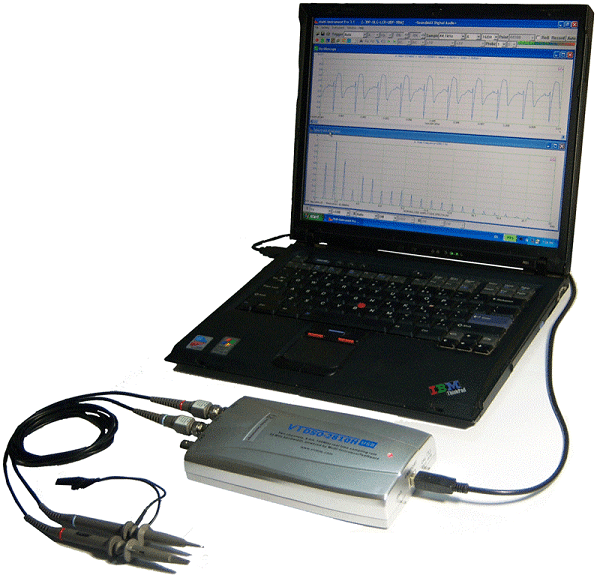
Measurements of PAL Composite Video Signals:
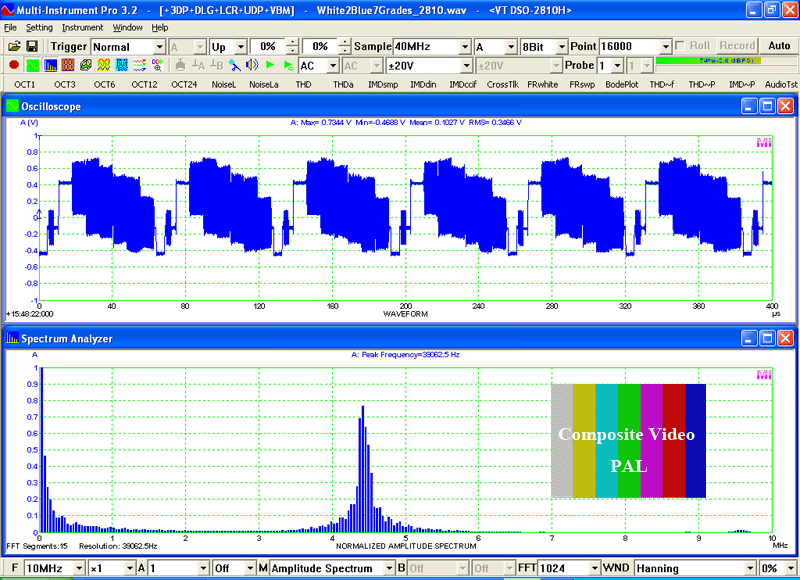
Measurements of a 500Hz sine wave and a 1kHz square wave under ALT trigger mode
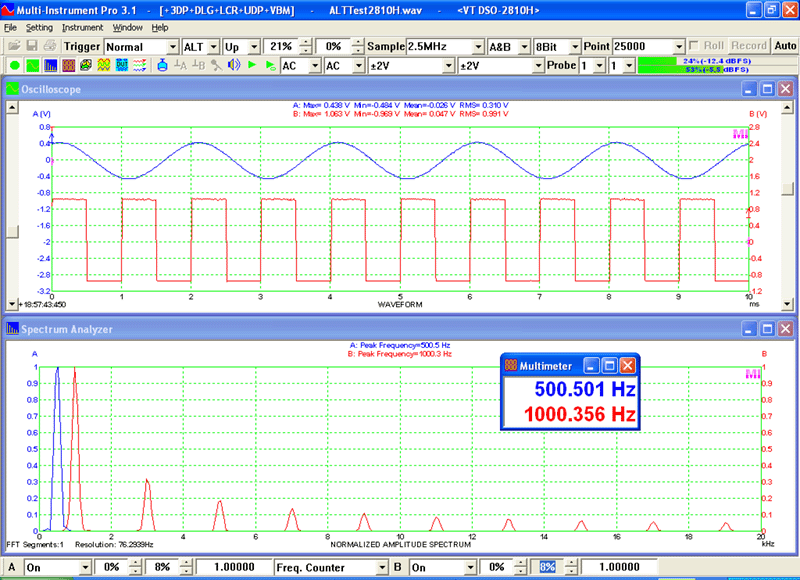
2. VT DSO-2815H (US$349.95, FREE shipping worldwide)
i) Single Channel, Maximum 60000 Samples*: 150MHz, 50MHz, 20MHz, 2MHz, 200kHz, 20kHz
ii) Single or Dual Channels, Maximum 30000 Samples per Channel: 75MHz, 25MHz, 10MHz, 5MHz, 2.5MHz, 1MHz, 500kHz, 250kHz, 100kHz, 50kHz, 25kHz, 10kHz, 5kHz
iii) Single or Dual Channels, Maximum 10000 Samples per Channel: 50MHz, 2.5kHz
iV) Single or Dual Channels, Maximum 500 Samples per Channel, work in Roll Mode**: 50Hz, 25Hz, 5Hz
*These frequencies (except 50MHz) are not listed in the sampling frequency selection combo box of the Multi-Instrument software. You need to enter the value directly into that combo box and then set the number of sampling channels to single, if you need to use these sampling frequencies.
**Under these sampling frequencies, adjusting the trigger mode, trigger source, trigger edge, trigger level, trigger delay will have no impact on the sampling.
2) Analog Bandwidth: 60MHz
3) Number of Input Channels: 2
4) ADC Bit Resolution: 8 Bit
5) Input Voltage Range: +-40mV, +-80mV, +-200mV, +-400mV, +-800mV, +-2V, +-4V, +-8V, +-20V
6) Maximum Allowed Input Voltage: +-35V
7) DC Accuracy: +-3%
8) Coupling Type: AC/DC
9) Input Isolation: No
10) Terminal Type: Referenced Single-Ended
11) Buffer Size: 30000 bytes per Channel
12) Scan Time: 400µs~100s (with buffer fully filled)
13) Trigger Source: CH1, CH2, EXT, ALT
14) Trigger Level: Adjustable
15) Trigger Edge: Rising, Falling
16) EXT Trigger Level: Adjustable in the range of -4V ~ 4V
17) Trigger Mode: Auto, Normal, Single
18) Pre-Trigger: 0~-100%
19) Input Impedance: 1 Mohms, 25 pF
20) Output Signal for Probe Calibration: 2Vpp, 1kHz, Square Wave
21) Streaming Supported: No
22) Interface: USB
23) Device Category in Multi-Instrument: VT DSO H2
24) Power: Bus powered by USB port, no external power source required.
25) Power Consumption: Max. 2.5W
26) Dimensions: 203 mm (L) x 99 mm (W) x 33 mm (H)
27) System Requirement: Windows 98 or above
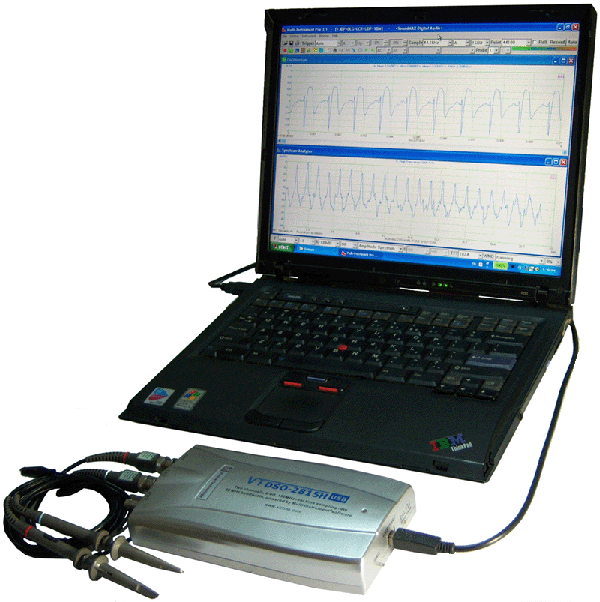
Measurements of PAL Composite Video Signals:
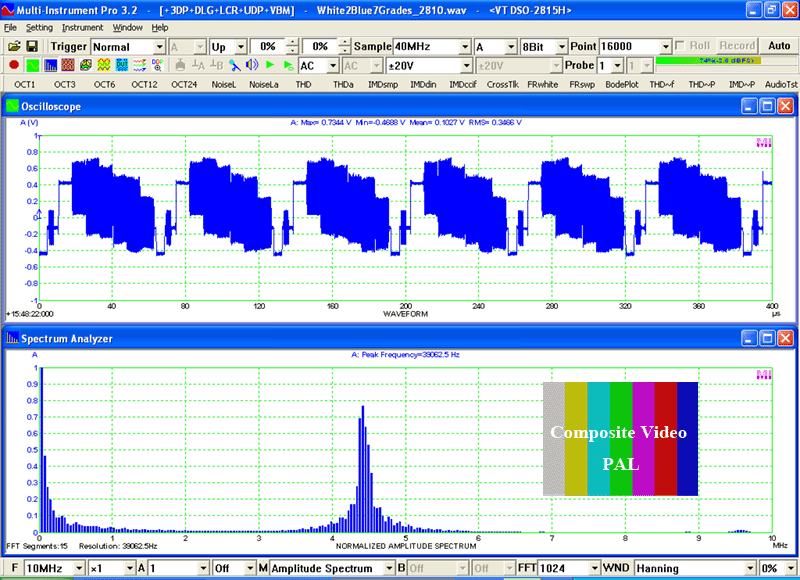
Measurements of a 500Hz sine wave and a 1kHz square wave under ALT trigger mode
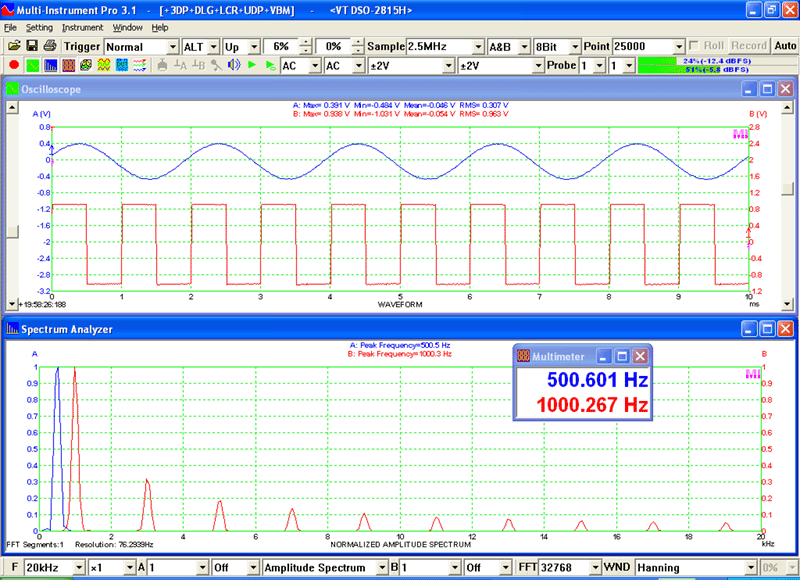
1. VT DSO-2810H (US$299.95,FREE shipping worldwide)
i) Single Channel, Maximum 60000 Samples*: 100MHz, 20MHz, 2MHz, 200kHz, 20kHz
ii) Single or Dual Channels, Maximum 30000 Samples per Channel: 50MHz, 25MHz, 10MHz, 5MHz, 2.5MHz, 1MHz, 500kHz, 250kHz, 100kHz, 50kHz, 25kHz, 10kHz, 5kHz
iii) Single or Dual Channels, Maximum 10000 Samples per Channel: 2.5kHz
iV) Single or Dual Channels, Maximum 500 Samples per Channel, work in Roll Mode**: 50Hz, 25Hz, 5Hz
*These frequencies are not listed in the sampling frequency selection combo box of the Multi-Instrument software. You need to enter the value directly into that combo box and then set the number of sampling channels to single, if you need to use these sampling frequencies.
**Under these sampling frequencies, adjusting the trigger mode, trigger source, trigger edge, trigger level, trigger delay will have no impact on the sampling.
2) Analog Bandwidth: 40MHz
3) Number of Input Channels: 2
4) ADC Bit Resolution: 8 Bit
5) Input Voltage Range: +-40mV, +-80mV, +-200mV, +-400mV, +-800mV, +-2V, +-4V, +-8V, +-20V
6) Maximum Allowed Input Voltage: +-35V
7) DC Accuracy: +-3%
8) Coupling Type: AC/DC
9) Input Isolation: No
10) Terminal Type: Referenced Single-Ended
11) Buffer Size: 30000 bytes per Channel
12) Scan Time: 600µs~100s (with buffer fully filled)
13) Trigger Source: CH1, CH2, EXT, ALT
14) Trigger Level: Adjustable
15) Trigger Edge: Rising, Falling
16) EXT Trigger Level: Adjustable in the range of -4V ~ 4V
17) Trigger Mode: Auto, Normal, Single
18) Pre-Trigger: 0~-100%
19) Input Impedance: 1 Mohms, 25 pF
20) Output Signal for Probe Calibration: 2Vpp, 1kHz, Square Wave
21) Streaming Supported: No
22) Interface: USB
23) Device Category in Multi-Instrument: VT DSO H1
24) Power: Bus powered by USB port, no external power source required.
25) Power Consumption: Max. 2.5W
26) Dimensions: 203 mm (L) x 99 mm (W) x 33 mm (H)
27) System Requirement: Windows 98 or above

Measurements of PAL Composite Video Signals:
An externally hosted image should be here but it was not working when we last tested it.
An externally hosted image should be here but it was not working when we last tested it.
An externally hosted image should be here but it was not working when we last tested it.

Measurements of a 500Hz sine wave and a 1kHz square wave under ALT trigger mode

2. VT DSO-2815H (US$349.95, FREE shipping worldwide)
i) Single Channel, Maximum 60000 Samples*: 150MHz, 50MHz, 20MHz, 2MHz, 200kHz, 20kHz
ii) Single or Dual Channels, Maximum 30000 Samples per Channel: 75MHz, 25MHz, 10MHz, 5MHz, 2.5MHz, 1MHz, 500kHz, 250kHz, 100kHz, 50kHz, 25kHz, 10kHz, 5kHz
iii) Single or Dual Channels, Maximum 10000 Samples per Channel: 50MHz, 2.5kHz
iV) Single or Dual Channels, Maximum 500 Samples per Channel, work in Roll Mode**: 50Hz, 25Hz, 5Hz
*These frequencies (except 50MHz) are not listed in the sampling frequency selection combo box of the Multi-Instrument software. You need to enter the value directly into that combo box and then set the number of sampling channels to single, if you need to use these sampling frequencies.
**Under these sampling frequencies, adjusting the trigger mode, trigger source, trigger edge, trigger level, trigger delay will have no impact on the sampling.
2) Analog Bandwidth: 60MHz
3) Number of Input Channels: 2
4) ADC Bit Resolution: 8 Bit
5) Input Voltage Range: +-40mV, +-80mV, +-200mV, +-400mV, +-800mV, +-2V, +-4V, +-8V, +-20V
6) Maximum Allowed Input Voltage: +-35V
7) DC Accuracy: +-3%
8) Coupling Type: AC/DC
9) Input Isolation: No
10) Terminal Type: Referenced Single-Ended
11) Buffer Size: 30000 bytes per Channel
12) Scan Time: 400µs~100s (with buffer fully filled)
13) Trigger Source: CH1, CH2, EXT, ALT
14) Trigger Level: Adjustable
15) Trigger Edge: Rising, Falling
16) EXT Trigger Level: Adjustable in the range of -4V ~ 4V
17) Trigger Mode: Auto, Normal, Single
18) Pre-Trigger: 0~-100%
19) Input Impedance: 1 Mohms, 25 pF
20) Output Signal for Probe Calibration: 2Vpp, 1kHz, Square Wave
21) Streaming Supported: No
22) Interface: USB
23) Device Category in Multi-Instrument: VT DSO H2
24) Power: Bus powered by USB port, no external power source required.
25) Power Consumption: Max. 2.5W
26) Dimensions: 203 mm (L) x 99 mm (W) x 33 mm (H)
27) System Requirement: Windows 98 or above

Measurements of PAL Composite Video Signals:
An externally hosted image should be here but it was not working when we last tested it.
An externally hosted image should be here but it was not working when we last tested it.
An externally hosted image should be here but it was not working when we last tested it.

Measurements of a 500Hz sine wave and a 1kHz square wave under ALT trigger mode

To measure higher voltage than +/-20V, use a x10, x100, or x 1000 oscilloscope probe
do you have a supplier and part numbers for x100 probes that work with this?
Compare the Virtin scope with this $300 scope -
Hantek USB Oscilloscope 200Ms/s DSO-5200 2ch VISTA++ | eBay
1. DSO5200 Pc Softscope is based on the portable digital storage oscilloscope. High-performance Dso5200 has the following features: 200Mhz: analog bandwidth, 200MSa/S: real-time sampling.
2. Is a control Dso5200 of windows software. Easy to use
Dso5200 Softscope easy-to-use, it is intuitive and easy to understand. Big screen
Dso5200 Softscope use 720 * 480 screen size. Multiple data formats
Dso5200 Softscope can waveform storage with the following format: DAT file, JIP / BMP graphics files, Eexcel / word document.
DSO5200 Softscope with 23 kinds of measurements.
Faster screen update rate
The use of hand-way analog oscilloscope makes a show result.
or this scope http://cgi.ebay.com/Hantek-DSO1200-...066?pt=LH_DefaultDomain_0&hash=item439debf782
Hantek USB Oscilloscope 200Ms/s DSO-5200 2ch VISTA++ | eBay
1. DSO5200 Pc Softscope is based on the portable digital storage oscilloscope. High-performance Dso5200 has the following features: 200Mhz: analog bandwidth, 200MSa/S: real-time sampling.
2. Is a control Dso5200 of windows software. Easy to use
Dso5200 Softscope easy-to-use, it is intuitive and easy to understand. Big screen
Dso5200 Softscope use 720 * 480 screen size. Multiple data formats
Dso5200 Softscope can waveform storage with the following format: DAT file, JIP / BMP graphics files, Eexcel / word document.
DSO5200 Softscope with 23 kinds of measurements.
Faster screen update rate
The use of hand-way analog oscilloscope makes a show result.
or this scope http://cgi.ebay.com/Hantek-DSO1200-...066?pt=LH_DefaultDomain_0&hash=item439debf782
Last edited:
Thank you all for your interest in our products.
Yes, USB 3 is becoming a standard PC configuration. As fas as virutal DSO is concerned, USB 3 offers two major advantages:
1. Allow Higher Data Transfer Rate (about 10 times higher)
5 Gbits/s (USB3.0) vs 480 Mbits/s (USB 2.0)
2. Allow Higher Current drawn from USB port (about 2 times higher)
500mA (USB 2.0) vs 900mA (USB 3.0)
Advantage 1 can help a virutal DSO to increase the max. ADC/DAC sampling rate at which the data can be recorded/output by the PC to the DSO CONTINUOUSLY. For example, for USB2.0, two channels ADC, bit depth = 8, the max. sampling rate for continuous streaming is determined by 480/2/8= 30MHz theoretically. For USB3.0, we can expect this max. sampling rate to go up to 300MHz theoretically. This will help those virtual DSOs which support streaming mode to utilize the modern PC's huge memory, or hard disk to store the data continously. (note: Many DSOs in the market do not support streaming mode, though)
Advantage 2 can help a bus-powered virtual DSO to use ADC/DAC chips with higher sampling rate in its circuit. Generally, the current drawn by an ADC/DAC chip increases with the its sampling rate. That's why the max. sampling rate of a bus-powered virtual DSO generally does not go beyond 250MHz. Therefore, we should expect the max. sampling rate of a bus-powered virtual DSO to go up using USB 3.0. (note: the max. sampling rate here is different from the one mentioned in Advantage 1. The max. sampling rate here is achieved by using the DSO's local buffer memory, and thus the record length is limited by the size of the local buffer memory.)
Pricewise, you can expect the virutal DSO with true USB 3.0 to be expensive in the first a few years, as the interfacing chip for USB3.0 is expensive for the time being.
A good news is that USB 3.0 is backword compatible with USB2.0, therefore virtual DSOs with USB2.0 will still work with USB 3.0.
Of course, the prices of our products may not be the lowest in the market if you only look at the max. sampling rate, but there are many other parameters/features you might need to consider as well depending on your applications. Basically we do not treat a virutal DSO as just a waveform viewer, we treat a virtual DSO as an analyzer, where you can do many analysis based on the data acquired. To name a few features not found in the products mentioned by peterpan73:
1. Support other hardware such as sound cards, NI DAQmx cards, as ADC device, DAC device or both. In the software, you can just go to [setting]>[ADC Device] or [DAC Device] to change the hardware used.
2. Signal Generator function.
Support using the DSO as the ADC device and other hardware such as a sound card as the DAC device at the same time. You can generate a signal via your sound card and measure it using the DSO. The signals can be generated includes: sine, square, triangle, white noise, pink noise, multitones, MLS, DTMF, musical scales, arbitrary, etc. Support frequency and amplitude sweep.
3. Many audio/acoustic measurement and analysis functions
THD, THD+N, IMD, frequency compensation, frequency weighting (A,B,C, ITU-R 468), Octave analysis (1/1, 1/3, 1/6, 1/12, 1/24, 1/48, 1/96). By the way, for audio/acoustic measurement and analysis, a sound card is generally bettern than a 8-bit DSO.
4. Digital filtering function in the Oscilloscope
low pass, high pass, band pass, band stop, arbitrary using FIR, IIR, FFT methods.
5. Reference Curves
6. Peak frequency measurement with sub-FFT-bin-size accuracy in the Spectrum Analyzer. As far as we know, we seem to be the only one offer this feature in the market.
.......
Yes, USB 3 is becoming a standard PC configuration. As fas as virutal DSO is concerned, USB 3 offers two major advantages:
1. Allow Higher Data Transfer Rate (about 10 times higher)
5 Gbits/s (USB3.0) vs 480 Mbits/s (USB 2.0)
2. Allow Higher Current drawn from USB port (about 2 times higher)
500mA (USB 2.0) vs 900mA (USB 3.0)
Advantage 1 can help a virutal DSO to increase the max. ADC/DAC sampling rate at which the data can be recorded/output by the PC to the DSO CONTINUOUSLY. For example, for USB2.0, two channels ADC, bit depth = 8, the max. sampling rate for continuous streaming is determined by 480/2/8= 30MHz theoretically. For USB3.0, we can expect this max. sampling rate to go up to 300MHz theoretically. This will help those virtual DSOs which support streaming mode to utilize the modern PC's huge memory, or hard disk to store the data continously. (note: Many DSOs in the market do not support streaming mode, though)
Advantage 2 can help a bus-powered virtual DSO to use ADC/DAC chips with higher sampling rate in its circuit. Generally, the current drawn by an ADC/DAC chip increases with the its sampling rate. That's why the max. sampling rate of a bus-powered virtual DSO generally does not go beyond 250MHz. Therefore, we should expect the max. sampling rate of a bus-powered virtual DSO to go up using USB 3.0. (note: the max. sampling rate here is different from the one mentioned in Advantage 1. The max. sampling rate here is achieved by using the DSO's local buffer memory, and thus the record length is limited by the size of the local buffer memory.)
Pricewise, you can expect the virutal DSO with true USB 3.0 to be expensive in the first a few years, as the interfacing chip for USB3.0 is expensive for the time being.
A good news is that USB 3.0 is backword compatible with USB2.0, therefore virtual DSOs with USB2.0 will still work with USB 3.0.
Of course, the prices of our products may not be the lowest in the market if you only look at the max. sampling rate, but there are many other parameters/features you might need to consider as well depending on your applications. Basically we do not treat a virutal DSO as just a waveform viewer, we treat a virtual DSO as an analyzer, where you can do many analysis based on the data acquired. To name a few features not found in the products mentioned by peterpan73:
1. Support other hardware such as sound cards, NI DAQmx cards, as ADC device, DAC device or both. In the software, you can just go to [setting]>[ADC Device] or [DAC Device] to change the hardware used.
2. Signal Generator function.
Support using the DSO as the ADC device and other hardware such as a sound card as the DAC device at the same time. You can generate a signal via your sound card and measure it using the DSO. The signals can be generated includes: sine, square, triangle, white noise, pink noise, multitones, MLS, DTMF, musical scales, arbitrary, etc. Support frequency and amplitude sweep.
3. Many audio/acoustic measurement and analysis functions
THD, THD+N, IMD, frequency compensation, frequency weighting (A,B,C, ITU-R 468), Octave analysis (1/1, 1/3, 1/6, 1/12, 1/24, 1/48, 1/96). By the way, for audio/acoustic measurement and analysis, a sound card is generally bettern than a 8-bit DSO.
4. Digital filtering function in the Oscilloscope
low pass, high pass, band pass, band stop, arbitrary using FIR, IIR, FFT methods.
5. Reference Curves
6. Peak frequency measurement with sub-FFT-bin-size accuracy in the Spectrum Analyzer. As far as we know, we seem to be the only one offer this feature in the market.
.......
Last edited:
Anyone used a 100x prope with one of these for tube HV work ? The scope referenced by peter shows a 100x probe in the manual, while I don't see mention with the vitual DSO.
As far as USB3, it may be a flash in the pan as Intel has yet to make it native even in their latest motherboards, they may have plans for LightPeak instead (which would be good as I am concerned about using a scope that shares ground with a noisy computer via USB.)
As far as USB3, it may be a flash in the pan as Intel has yet to make it native even in their latest motherboards, they may have plans for LightPeak instead (which would be good as I am concerned about using a scope that shares ground with a noisy computer via USB.)
Last edited:
The 1 Mhz signal gen function may not be very attractive considering that hobbyists these days get a 60Mhz function generator out of a $20 AD9851 DDS board on ebay or a Silicon Labs RF gen chip like the Si41XX series chips. And for those into the < 500Mhz spectrum anlayzers kind of work, I'd suggest a DIY Elektor 400Mhz waveform generator/ Spec analyzer that would cost $150 in India.
Last edited:
Hi, peterpan73, AD9851 is a good chip which offers a simple way to generate sine wave in tens of MHz. But it is not included in any of the competing DSO products you mentioned. The retail price for AD9851 chip itself is about US$20. Of course, by adding a few resistors, capacitor, wires around, one can construct a sine/square wave generator, but DIY is another story.
The drawback of AD9851 is that it can only generate sine/square wave. It does not seem to offer a choice to download arbitrary data to its DDS buffer in order to generate arbitrary waveform. Moreover, it cannot generate white noise, pink noise, frequency sweep (at least without a proper software or additional hardware), etc. These signals are generally required for frequency response measurement. The bit depth of AD9851 is only 10 bit. Therefore, its generated waveform can be used for viewing only, but cannot be used for measurements such as THD, THD+N, which requires very low distortion of the signal source.
The drawback of AD9851 is that it can only generate sine/square wave. It does not seem to offer a choice to download arbitrary data to its DDS buffer in order to generate arbitrary waveform. Moreover, it cannot generate white noise, pink noise, frequency sweep (at least without a proper software or additional hardware), etc. These signals are generally required for frequency response measurement. The bit depth of AD9851 is only 10 bit. Therefore, its generated waveform can be used for viewing only, but cannot be used for measurements such as THD, THD+N, which requires very low distortion of the signal source.
Displays??
@ Stratus.
which display do you have in mind? The hantek PC Scopes or the Elektor spec analyzer??
@ Virtins
Thats true, but I've never been too fond with all in one combos devices. I like them all separate. I guess the Virtin scopes are useful to people in the low spectrum industry(audio and VLF) but from an RF point of view, they just don't cut it. I do a lot of testing of homebrew RF filters and RF sig sources so the http://www.elektor.com/magazines/20...ency-generator-spectrum-analyser.684208.lynkx Elektor sweep gen, waveform gen/spec analyzer helps. To each his own.
PCBs for the Elektor spec.analyzer project are available with me if anyone's interested.
@ Stratus.
which display do you have in mind? The hantek PC Scopes or the Elektor spec analyzer??
@ Virtins
Thats true, but I've never been too fond with all in one combos devices. I like them all separate. I guess the Virtin scopes are useful to people in the low spectrum industry(audio and VLF) but from an RF point of view, they just don't cut it. I do a lot of testing of homebrew RF filters and RF sig sources so the http://www.elektor.com/magazines/20...ency-generator-spectrum-analyser.684208.lynkx Elektor sweep gen, waveform gen/spec analyzer helps. To each his own.
PCBs for the Elektor spec.analyzer project are available with me if anyone's interested.
Last edited:
Hi, stratus46, could you give more clue on this? Thanks.
Here is a link to Tektronix, one of the best in the TV industry.
Basic Video Testing -- Waveform Monitor Techniques > NTSC Video Measurements > Application Note : Tektronix
Figure 2-5 is an NTSC display of 2 lines of SMPTE color bars. 75% PAL color bars is very similar to NTSC. Note the amplitude of the color burst immediately following the sync pulse. It's the same as the sync pulse. Also note the amplitude of the subcarrier within the line. The NTSC signal is band limited to 5.5 MHZ (4.2 MHz after being transmitted ) and the Tektronix scope itself only has 8-10 MHz of bandwidth as I've used these for over 20 years.
Since your display is so rolled off on the high end I can only conclude that either the generator is VERY poor (broken) or the scope has severe roll-off. Certainly nowhere near 100 MHz. The display you show isn't flat to 2 MHz - about the quality of a VHS tape.
The bench scope I use at work, DPI-3054 has real 500 MHz bandwidth. My personal scope is an old Tek 475A that does 250 MHz.
G²
Last edited:
- Home
- Vendor's Bazaar
- 2x100MHz PC USB Oscilloscope, Spectrum Analyzer, Multimeter, Signal Generator*